The appearance of pimples is one of the body’s ways to adapt to various changes. They can occur in children of any age. Parents should be able to determine the type of acne that appears, as well as the reason that contributed to its formation. This will help treat annoying rashes and also prevent them from occurring in the future.
Why do children get acne?
There are a huge number of reasons why acne appears on a child’s face. They may be related to the following processes:
- Allergic reaction.
- Intestinal dysbiosis.
- The baby will overheat.
- Viral disease.
- Improper hygiene.
- Hormonal imbalance.
- Increased sebaceousness of the skin glands.
Each of these reasons deserves a mandatory consultation with a doctor. This is the only way to prevent further rashes and alleviate the baby’s condition.
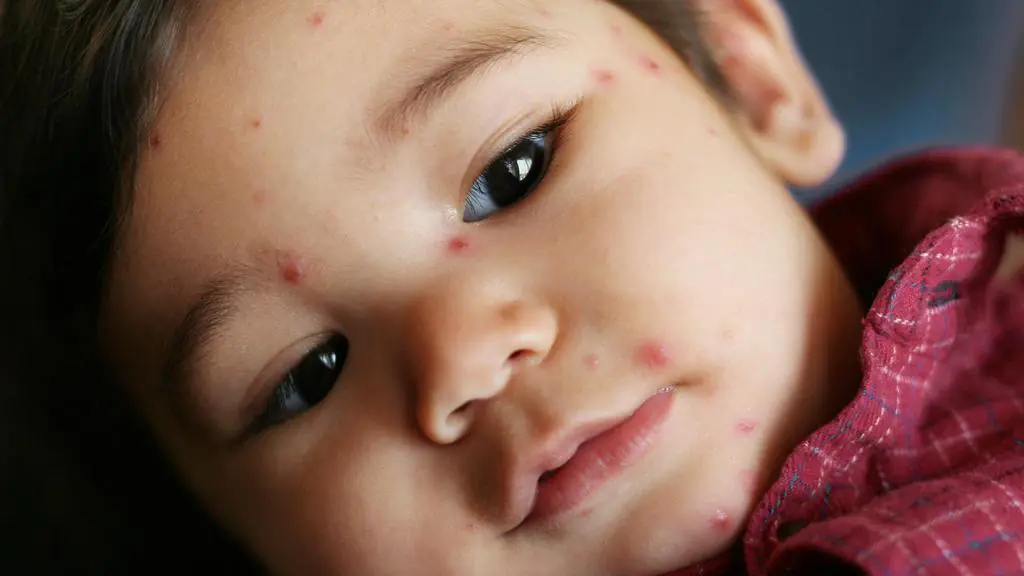
Non-infectious acne in children of different ages
Regardless of age, doctors distinguish between infectious and non-infectious types of acne. The first category includes the following rashes:
- Prickly heat.
- Hormonal acne.
- White dots.
- Allergic reaction.
- Pustules.
In most cases, acne on a child’s face does not indicate serious health problems. The most harmless rashes on this list include white pimples and hormonal acne. Other types of non-infectious rashes should be checked by a doctor to determine further treatment.
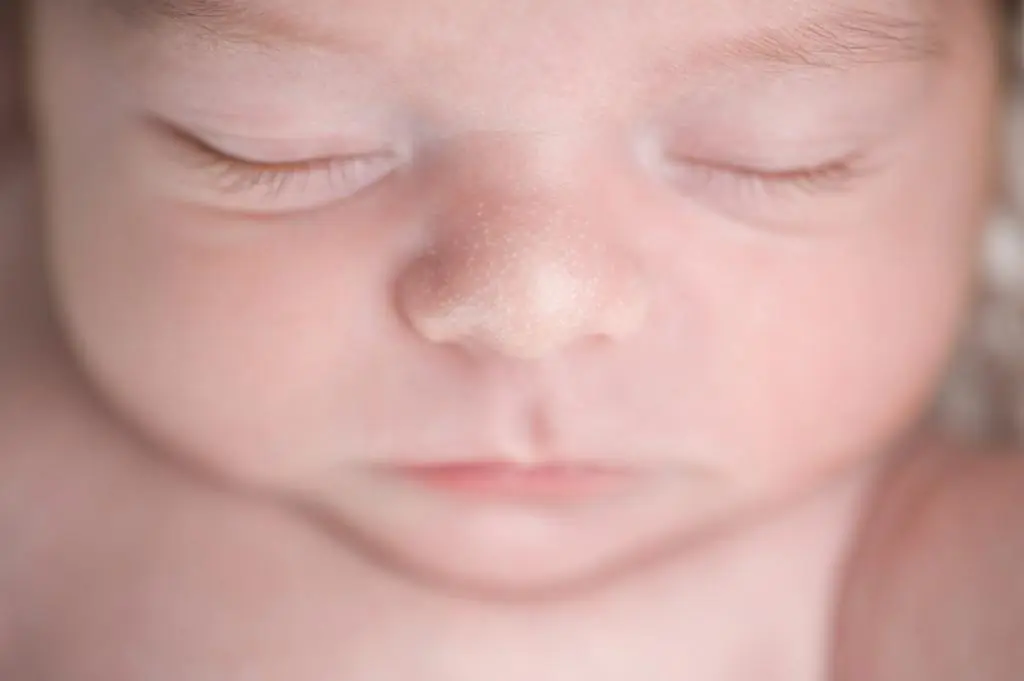
Infectious acne
These types of acne belong to the category of dangerous rashes. They are the main symptom of a viral infection in the body. Most often they appear when:
- Herpes. The rash is red and itchy. Very similar to small bubbles.
- Folliculitis. Pimples contain pus, hurt and can burst.
- Scarlet fever. The disease manifests itself as itchy and dry small pimples.
- Rubella. Pimples are pink in color and quickly spread throughout the body.
- Streptodermatitis. The rash has a distinct red outline.
Infectious acne on a child's face requires treatment, as does the disease itself that caused it. Therapy is carried out using medications, ointments, gels and creams to heal the skin.
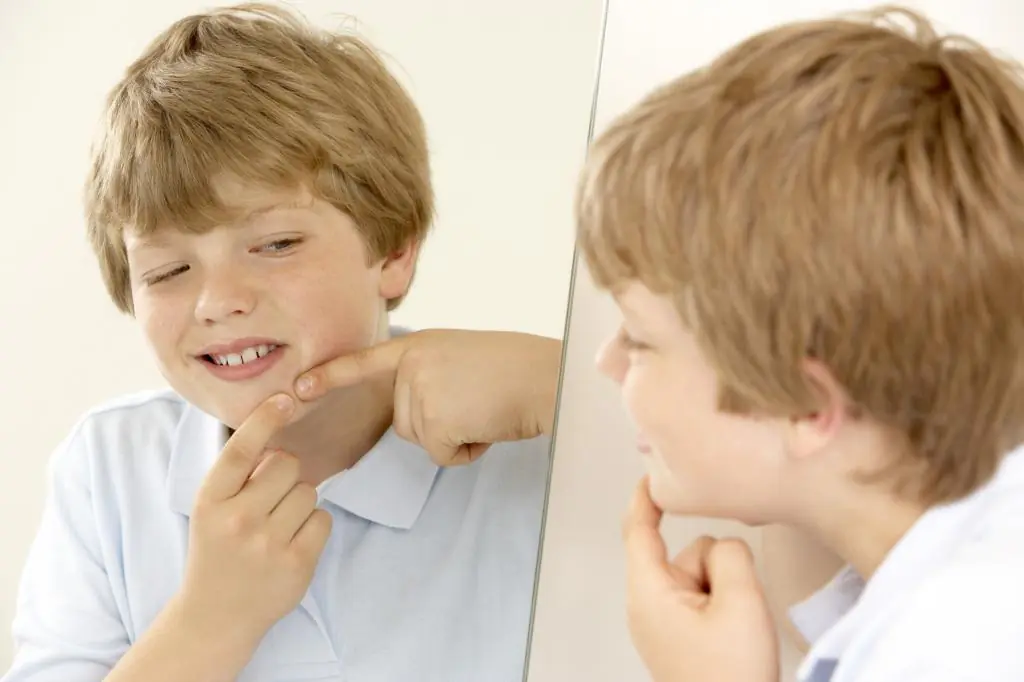
How to treat infectious acne on the face
When a child suffers from a viral disease, acne may appear on his face, which is considered one of the signs of a particular illness. Some diseases show their first symptoms in the form of rashes on the face. In this case, parents should go to the hospital in time and diagnose the infection in the baby’s body.
Next, doctors take care of his appropriate treatment. Therapy is most often carried out using antibiotics and other serious drugs. Acne on a child's face always goes away along with the infection during the recovery period. Therefore, it makes no sense to treat them separately, because they are only a consequence of the disease. However, during the treatment period it is necessary to ensure that the child adheres to the following recommendations:
- Pimples should not be squeezed, scratched or picked off. Otherwise, after recovery, scars will remain on your face and body.
- In order not to damage the wounds, you need to put special soft mittens on your child’s hands every night, which will prevent pimples from being ripped off the face.
- Treat rashes with a bactericidal solution every day.
If you follow these rules, your child’s recovery will be much easier.
Acne in babies
After birth, the child’s body has to adapt in every possible way to environmental conditions. He begins to live and develop separately from the mother's womb. Because of this new condition, his internal organs and skin begin to work even more actively. Therefore, many parents often encounter such a nuisance as acne in children.
In infancy, the child's rashes are white and red. The most harmless are small white pimples of a hormonal nature. They appear in the baby immediately after birth and can bother parents for a short period of time. The rashes are localized on the forehead, eyelids, under the eyes, and also on the cheeks. Pimples of this type closely resemble small white bumps. They don't hurt and rarely itch. Therefore, parents manage to quickly rid their baby of them.
Red pimples on a child's face are not always considered a harmless symptom. Such rashes can be caused by an inflammatory process in the body, which is caused by infection with microbes or viruses. They are also the result of improper hygienic care of the baby and failure to maintain a comfortable temperature in the room. Regardless of the cause of red pimples on the face of a child, you should immediately seek advice from a pediatrician.
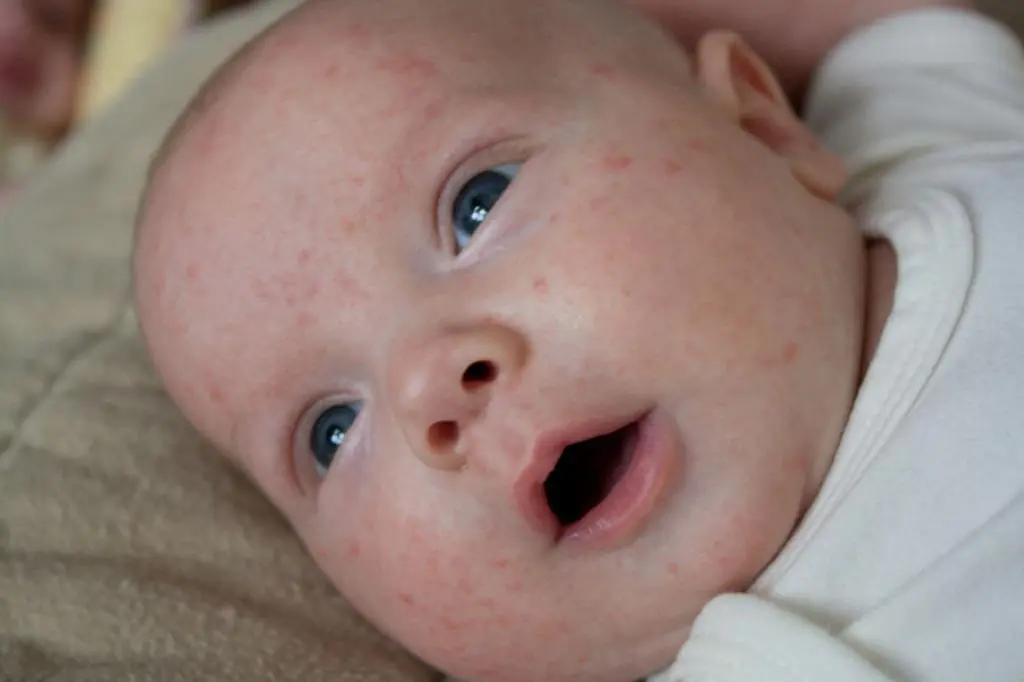
Types of acne in babies
During the first year of life, many children develop rashes on the skin of the face and body. They are mostly white or red. To determine the cause of their appearance, it is necessary to be able to distinguish between all types of acne, which most often appear in infants.
Milia are white and small pimples on the baby's face that do not cause him concern. If such acne appears on the face of a month-old baby, there is no need to worry. This type of rash is only a consequence of the normal functioning of hormones. They do not require treatment and go away on their own.
Infant acne is small purulent pimples that appear under the influence of the mother's female hormones. They should not be a cause for concern, but if the rashes persist, it is better to consult a doctor.
Miliaria is a very common occurrence in infants, which is manifested by redness of the skin in the neck and armpits. Such a deviation often occurs after non-compliance with the temperature regime indoors or outdoors.
Another type of most common rash in infants is allergic pimples. They can form from poor nutrition of the mother, inappropriate children's cosmetics, as well as from washing powder with an aggressive composition. If your baby is one month old, and acne on the face causes severe concern, it is better to consult a doctor.
Treatment of acne in babies
Depending on the type of acne, your doctor may prescribe the following treatment methods:
- Bepanten cream or powder from the same company. This is how diaper rash and prickly heat are treated.
- Baths with the addition of herbal infusions: sage, calendula, chamomile, string herbs, etc. With the help of medicinal herbs, you can remove white pimples on a child’s face, as well as remove all redness.
- For allergic rashes, a nursing mother is prescribed a strict diet. If your baby is fed artificial formula, it is necessary to reconsider his diet.
- Acne on a child’s body can be wiped with Furacilin.
- Some rashes will need to be treated with antihistamines.
- If you have chickenpox, you will be prescribed to treat the skin with regular brilliant green.
Every parent should remember that if a child has acne on his face, self-medication is dangerous. Especially when it comes to his health. Even the smallest red bumps on a baby's body should cause adults to see a doctor. Only he can prescribe the treatment the child needs.
Preventing rashes in babies
To prevent the development of rashes, it is necessary to promptly determine the causes of acne on a child’s face, provide good skin care, and also not neglect visiting doctors. Any self-medication can harm the baby’s health. Regardless of the type of rash, the body is first diagnosed. Only after a comprehensive examination can you carry out the treatment and prevention measures prescribed by your doctor. If acne appears on the face and body, consultation is given by an immunologist and an allergist.
Prevention of rashes depends on the age of the child. To prevent the appearance of acne in babies, it is necessary to control the temperature in the place where it is located, carry out bathing procedures only with organic cosmetics, and the mother will have to strictly monitor the feeding of the baby. When breastfeeding, you need to eat a strict diet, and when feeding artificial formulas, give preference to the most famous manufacturers.
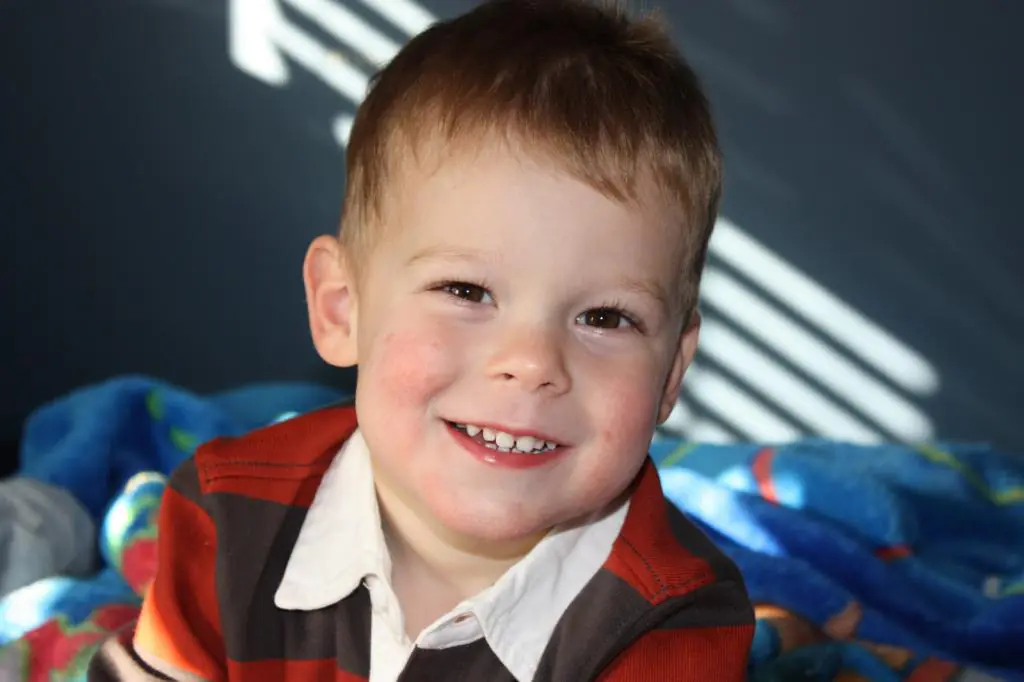
Acne in preschool and teenage children
Every mother will worry about the condition of her child when acne appears. And it doesn’t matter at all how old this child will be. Parents are always worried about the well-being of their child. Therefore, it is necessary to highlight the main causes of acne in preschool and adolescence:
- Teething. This process can cause a lot of discomfort to the baby and also cause rashes on the face. The location of such acne is always the area around the mouth. The reason for this is the child’s increased salivation during this period.
- Allergic reaction. Pimples of different diameters can occur in children due to allergies. These rashes are known for their rapid onset. An acne rash can spread across your face instantly. However, they are almost always accompanied by itching, runny nose, sneezing or tearing. Treatment is carried out by eliminating the allergen.
- The body's reaction after vaccination. It can be extremely individual. Therefore, they cannot be diagnosed at home. If pimples appear after vaccination, you should immediately consult a doctor.
- Lack of personal hygiene. Children's skin is very thin. Therefore, she reacts sensitively to the lack of quality cleansing. Teenagers may develop blackheads, and then acne. Therefore, you need to purchase soft and gentle cosmetics for washing.
- Insect bites. Red and swollen bumps on a child may indicate insect bites. Most often they are located unevenly and in different parts of the face and body. To prevent this from happening, it is necessary to use special creams that repel insects.
- Dysbacteriosis of the gastrointestinal tract. Judging by numerous photos, acne on a child’s face due to stomach problems looks like a small and itchy rash. It appears on the face, as well as around the hair growth on the head.
- Puberty. This type of acne can look quite scary. However, do not be scared and run to the doctor. Comedones, blackheads and acne appear in adolescence due to changes in the body. Over time, this age-related phenomenon passes. You just need to teach your child to eat right, drink more clean water and use special cosmetics that will help get rid of acne.
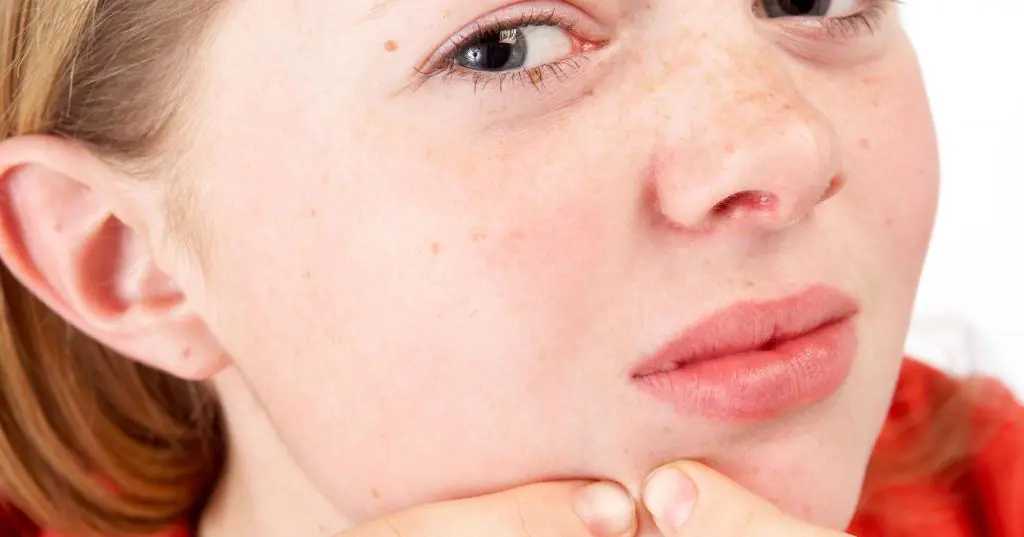
What should parents do if acne appears?
When a child has acne on his face, not all parents know what to do. Therefore, you need to try to prevent their occurrence. To prevent rashes in preschool children, you must first monitor their diet. In kindergarten or visiting friends, a child may eat a product that will cause him an allergy.
Particular attention should be paid to possible locations of acne. Having noticed a couple of pimples on the face, you need to immediately examine the child’s entire body. Some infectious diseases begin with rashes on the face and spread throughout the body. If you don't pay attention to small pimples, you may miss the symptoms of a dangerous infection.
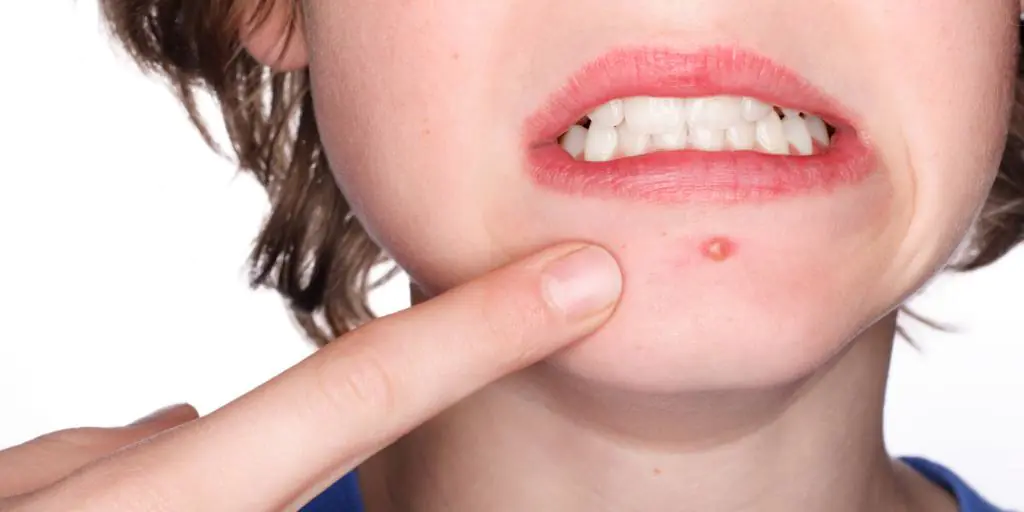
Preventing rashes in teenagers
As a teenager, you should always carefully monitor the condition of your facial skin. Acne during this period of a child’s life may appear due to hormonal changes in the body. The activity of the sebaceous glands begins to intensify, and this provokes the development of acne and blackheads.
Do not remove pus from pimples, squeeze them out or pick them off the skin. Such actions can only spread the activity of bacteria throughout the face. Even more pimples will appear after this. Parents should teach their child personal hygiene aimed at gently cleansing the skin and drying out inflamed acne. You can prevent their occurrence by normalizing your diet, increasing physical activity and walking in the fresh air.
The appearance of acne on a child’s face can have different etiologies, depending on age, nutrition, the presence of allergic reactions and hygiene. Some of them may indicate the development of a serious pathology in the baby’s body.
There are also those that appear in the first days of life and are associated with maternal hormones; they do not require treatment and go away on their own by the age of seven months.
Causes
Baby acne can have many causes; it is not necessarily an infectious disease. But they all require a serious approach, consultation with a pediatrician and treatment. The etiology of the rash is determined by appearance, location, type and age of the child.
The main reasons that allow for primary diagnosis are identified:
- disruption of the sebaceous glands;
- unstable hormonal levels;
- allergic reaction;
- bacterial infections such as folliculitis or scarlet fever;
- viral infections – chickenpox, herpes;
- prickly heat;
- pathologies of the digestive system;
- poor nutrition;
- reaction to insect bites;
- improper skin care, use of low quality hygiene products;
- lack of hygiene.
Varieties
Children's acne may differ from each other in color, structure, content, location and the presence of additional symptoms.
The most common types of acne in childhood are:
Each of these types has its own characteristic differences, etiology and method of treatment.
Reds
Rashes in the form of red pimples on a child’s face are most often pathological in nature and are an alarming sign.
Causes of red pimples:
- an allergic reaction, most often associated with the diet of a child or nursing mother, may have a medicinal etiology, and is usually accompanied by itching;
- an infectious disease - scarlet fever, has characteristic additional symptoms: fever, inflammation of the tonsils, enlarged lymph nodes in the neck, requires an immediate call to the doctor;
- chickenpox - rashes have a characteristic external sign - a transparent pimple with a red rim and sticky contents, are localized not only on the face, and are accompanied by high fever and itching.
This kind of rash cannot be ignored; an allergic skin reaction can develop into atopic dermatitis and remain for many years.
With chickenpox, it is necessary to ensure that the child does not scratch pimples or pick off scabs; round scars can remain for life.
Infectious diseases, especially scarlet fever, require serious treatment with antibiotics; advanced forms can provoke intoxication of the body and cause unwanted complications.
With transparent content
The most common cause of baby acne with clear contents is prickly heat. This is a signal to the mother that caring for the child is not correct. If the provoking factors are not eliminated, acne can become inflamed and filled with pus.
Causes of prickly heat:
- lack of baby skin care;
- clothing inappropriate for the external temperature;
- baby clothes made of synthetic fabrics.
Miliaria must be eliminated so as not to cause infection of the baby's skin with pathogenic microorganisms.
In some cases, pimples with transparent contents can be localized in the area of the baby’s mouth and nose. This is a herpes infection; such rashes signal a decrease in immunity and cause serious discomfort to the child. They are accompanied by pain, itching and increased salivation. Requires pediatrician consultation and treatment.
Blackheads. More details here.
White
Small white pimples occur in newborn babies due to a malfunction of the sebaceous glands, which is associated with maternal hormonal levels. Most often, small white pimples are localized in the nose area and disappear on their own by the age of seven months.
In some cases they can remain for up to a year and do not require special treatment. It is enough to maintain baby skin hygiene and use only certified baby cosmetics.
Prevention
It is impossible to prevent childhood acne, which is characteristic of infectious diseases. When they appear, parents must respond promptly and show the child to a doctor. The main thing is to make a correct diagnosis and carry out adequate therapy.
Preventive measures for other acne on a child’s face come down to following some recommendations:
- monitor the temperature and humidity of the room in which the child is located;
- it is necessary to ensure proper care of the baby’s skin;
- You need to wash clothes with special hypoallergenic products;
- monitor the diet of not only the child, but also the breastfeeding mother;
- strengthen children's immunity;
- before a walk, it is necessary to apply children’s products to the skin of the face that protect from sun rays or frost;
- maintain hygiene of toys and pacifiers;
- teenagers use special lotions for facial skin;
- Never squeeze pimples on your face.
The main preventative measures are hygiene and a balanced diet.
Treatment of childhood acne on the face of a child in the first years of life
Treatment should be prescribed by a pediatrician after an accurate diagnosis has been made. In newborns, white pimples do not require treatment; they will go away on their own within a year. If you suspect an allergic reaction or an infectious disease, you need to take a blood test.
Childhood acne in children under 2-3 years of age is treated depending on its origin:
- for prickly heat, washing with water with the addition of manganese or chamomile decoction is recommended, as well as observing the temperature regime in the room;
- chickenpox is treated by lubricating acne with an antiseptic composition, for example brilliant green; given the viral nature of the rash, the doctor may prescribe antiviral agents;
- the allergic reaction can be controlled with antihistamines; if necessary, the doctor can prescribe hormonal ointments;
- if acne is caused by an external factor (sun, frost, wind, high humidity, heat), you can lubricate the baby’s face with Bepanten cream, it will soften the skin and eliminate irritation;
- folliculitis is treated with antibacterial agents, and the pimples themselves must be wiped with a furatsilin solution.
It is not recommended to lubricate the skin of young children with creams; the pores on the face will become clogged, which will cause the appearance of new acne.
Soap for washing a child can be used only once a day, otherwise it can provoke increased production of sebaceous secretions.
After bathing, you should not rub your child’s skin with a towel; just blot it slightly, this will help avoid microtrauma to the epidermis.
In preschoolers
If acne appears on the face of a child 3-7 years old, most often it is herpes or a bacterial infection. They are filled with a sticky transparent liquid, over time they burst, get wet, and then dry out.
In children at this age, the functioning of the sebaceous glands is usually already established and hormonal levels are normalized, so the appearance of acne requires a medical examination.
If childhood acne is not associated with pathological production of androgens, hydrocortisone cream or ointment containing silver ions can be used for treatment. But the prescription must be made by a doctor, based on the child’s medical history and age.
If acne is red, bothersome, and does not go away for a long time, retinoid cream is used as an external remedy.
It is necessary to pay attention to the preschooler’s diet and exclude fatty foods, baked goods, smoked foods and sweets. All of these foods can disrupt the endocrine system.
You should explain to your child that you should not touch or squeeze pimples with your hands, as this can cause an infectious disease.
Once a day, pimples can be wiped with a 3% solution of salicylic alcohol or hydrogen peroxide. Inflamed pimples can be lubricated with Tetracycline or Erythromycin ointment.
In teenagers
Treatment of acne in adolescence should only be carried out under the supervision of a cosmetologist or dermatologist. The appearance of a rash is most often associated with hormonal changes in the body.
To prevent pimples from becoming inflamed, you can lubricate them with Zinc ointment or Zinerite; in addition to zinc, it also contains an antibiotic.
If the rash is purulent, with subcutaneous formations, a course of treatment with oral antibacterial agents is required - Azithromycin or Erythromycin. You can also use ointments externally to regulate the functioning of the sebaceous glands.
Doctor Komarovsky's opinion
Dr. Komarovsky believes that acne in young children goes away on their own with proper nutrition and care, and gives some advice:
- do not squeeze pimples;
- use cosmetics approved for use in children from the first days of life;
- nursing mothers need to monitor their diet and emotional state; stress provokes increased production of cortisol, which causes white pimples in the baby;
- The child must take air and sun baths.
Video: About rashes on the cheeks of a one-year-old child
Traditional methods
To treat childhood acne, you can use traditional medicine recipes in parallel with drug therapy:
- aloe - you can use the leaves or juice of the plant to lubricate acne on the face, it eliminates inflammation and disinfects the skin;
- plantain - prepare juice from fresh leaves and wipe your face with it, improves blood circulation and has an antiseptic effect;
- St. John's wort - a decoction of dried flowers can be prepared by pouring boiling water over them, at the rate of 2 tbsp. l. 500 ml, cool, strain and use to wipe the face;
- calendula - has a pronounced anti-inflammatory and antiseptic effect; the flowers of the plant can be brewed and wiped with the composition on the face.
It is also recommended to use viburnum and sea buckthorn berries for medicinal masks; they will saturate the skin with vitamins and strengthen the body’s immune system.
If redness on the skin and pimples on the child’s face do not go away for a long time, it is better to show the baby to the pediatrician, because at first glance, harmless pimples may indicate the progression of a dangerous pathology in the body, which is important to diagnose and begin to treat in a timely manner. Even a 6-month-old baby can develop a rash on the delicate skin. If parents do not know its nature, self-medication is contraindicated.
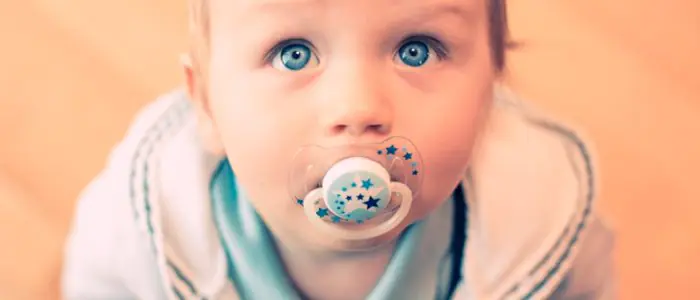
Main causes
Most often, small pimples on a child’s forehead, chin or nose do not pose any threat to health and disappear on their own after normalizing nutrition and observing personal hygiene rules.
In children under one year of age, a rash on the face can form as a result of the influence of an allergic, hereditary or infectious factor. Subcutaneous white pimples in a newborn often indicate endocrine disorders, which are a consequence of the hormonal crisis of newborns. A rash on the face at the age of 9-12 may indicate hormonal changes, viral infection, parasitic infestation, or malfunction of the gastrointestinal tract.
What types of rashes are there?
In a small child, pimples are classified according to different criteria. Considering the shape and filling, the following varieties are distinguished:
- tubercles;
- pink or red spots;
- blisters;
- papules;
- colorless bubbles;
- ulcers.
Depending on the color, the following types of acne on the face in young children are distinguished:
The correct diagnosis will be made by a pediatrician.
Reds. Many rashes not only on the skin of the face, but throughout the body may indicate the infectious nature of the rash and the progression of measles, rubella, scarlet fever, and chickenpox in the body. And also red pimples on the body often occur under the influence of an allergic factor. Failure to comply with personal hygiene rules and poor diet are also the reasons why dry acne appears.
White. Small pimples on the forehead and acne on the nose in a teenager indicate hormonal changes. A white rash on the face can also be a consequence of poor nutrition, the use of low-quality cosmetics, and dysfunction of the sebaceous glands. Transparent pimples. In newborns, such rashes occur under the influence of a hormonal factor on the body. If such pimples appear on the nose, forehead and chin, it is better to show the baby to the pediatrician, but often this condition is not dangerous and does not require treatment. Small pimples. A one-year-old child may have symptoms of an allergic reaction, viral infection and progression of dermatological diseases such as erythema, urticaria, pyoderma. Purulent. A large pimple with purulent contents in boys or girls aged 7 years may indicate improper facial skin care, non-compliance with nutritional rules, abuse of low-quality decorative or skincare cosmetics, and disruption of the functioning of the gastrointestinal tract.Return to contents
Features in newborns
If acne appears in a child in the first 2-3 months of life, then this is most likely a consequence of hormonal changes, which are typical for some babies immediately after birth. Hormonal imbalance in the body occurs due to an excess of maternal hormones in the baby’s blood. Such pimples do not hurt, do not itch and do not cause discomfort. They go away on their own without requiring treatment.
Children's pimples can also have an infectious etiology, causing the following diseases:
Other symptoms
If acne on the face of a 3-year-old child occurs due to insufficient skin hygiene or the use of low-quality cosmetics, then there will be no pronounced symptoms. Sometimes itching, redness and discomfort may occur. When childhood pimples occur as a result of internal disorders, the following symptoms may appear:
- increased body temperature;
- cough, sneezing, runny nose, increased lacrimation;
- swelling of the mucous membrane;
- burning, itching and peeling of the skin;
- enlarged lymph nodes;
- general malaise;
- headache.
Return to contents
Diagnostic methods
If red or white acne on the face of children does not go away for a long time and also causes a lot of discomfort, it is better to show the baby to a pediatric dermatologist. After an initial examination, palpation and history taking, the doctor will prescribe a dermatoscopy. Sometimes, to clarify the diagnosis, you will need to submit samples for pH testing and bacteriological examination.
What treatment is prescribed?
Drugs
If the rash occurs as a result of the progression of any internal pathology in the body, first of all, therapy is prescribed to eliminate the cause of acne. For children, the treatment regimen is selected individually and often includes the following groups of drugs:
- antiviral;
- antimicrobial;
- antihistamines;
- antiseptics;
- vitamins, immunostimulants.
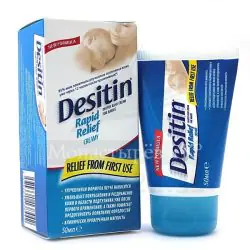
Desitin ointment performs well.
It is recommended to treat the flaky spot with Desitin and Bepanten ointments; soft baby creams, which should be prescribed by a doctor, also help to cope with rashes. If a child is not yet 1 year old, but already has rashes, it is forbidden to lubricate the pimples with iodine, brilliant green, or peroxide at your own discretion, as this can only worsen the situation. Sometimes drug therapy alone cannot get rid of the problem. Then the doctor will recommend laser cauterization, which increases the sensitivity of tissues to drug treatment, which will speed up recovery.
Physiotherapy
To eliminate acne, dermatologists often recommend that teenagers use physiotherapeutic procedures, the main purpose of which is to cleanse the skin, normalize blood circulation and tissue nutrition, and prevent the accumulation of subcutaneous fat in the pores. The following methods have proven themselves well:
- transsolvanization;
- FUV irradiation;
- ozone therapy;
- ultratonotherapy;
- magnetic therapy;
- ultraphonophoresis;
- paraffin and ozokerite applications;
- Thalassotherapy;
- electrophoresis;
- franklinization;
- UHF.
Return to contents
Folk remedies
Non-traditional methods also help to effectively combat pimples of various etiologies in children, but before using such remedies you should consult a doctor, which will help avoid dangerous consequences. If a cold pimple appears on your forehead, nose or chin, it is recommended to prepare a bactericidal infusion that will help get rid of inflammation faster. The recipe is:
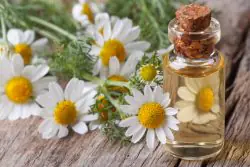
Cold pimples can be treated with herbal infusions.
Mix chamomile, sage and string in equal proportions.
Separate 1 tbsp from the mixture. l. and pour all 250 ml of boiling water. Let the product sit for 20 minutes, then strain. Soak gauze or a cotton pad in the prepared infusion and apply to the inflamed area for half an hour. Apply the compress 2-3 times a day, within a day the pimple will shrink in size and stop hurting.Antiseptic herbal infusion is recommended to be added to bathing water. Regular use of the product helps reduce the amount of rash, relieve itching, burning, peeling and inflammation. The natural medicine is safe even for newborns, and it is no less effective for older children.
Prevention
In order for a child of any age to be bothered by acne as little as possible, it is recommended first of all to improve nutrition, teach how to observe personal hygiene rules, buy only high-quality children's cosmetics, and increase the body's protective functions. To avoid complications, any suspicious pimple should not be lubricated with brilliant green, iodine or other aggressive liquids. It is better to show the child to a pediatric dermatologist, who, if necessary, will select the correct and safe treatment.



